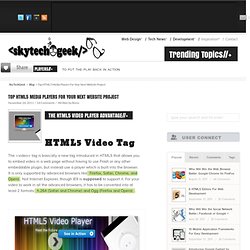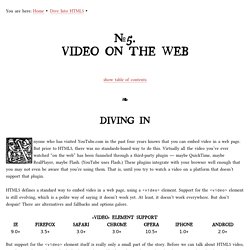

Top HTML5 Media Players For Your Next Website Project. The HTML5 Video Player Advantage//+ HTML5 Video Tag The <video> tag is basically a new tag introduced in HTML5 that allows you to embed video in a web page without having to use Flash or any other embeddable plugin, but instead use a player which is built into the browser.

It is only supported by advanced browsers like Firefox, Safari, Chrome, and Opera. Not Internet Explorer, though IE9 is supposed to support it. For your video to work in all the advanced browsers, it has to be converted into at least 2 formats: h.264 (Safari and Chrome) and Ogg (Firefox and Opera) . VP8, a new codec from On2/Google, may eventually remove the need for multiple versions, but that could take some time. Below we have collected some of these HTML5 Video Players , we hope you will find the one which suits your needs and requirements. 1. Open Standard Media (OSM) Player is an all –in-one media player for the web. Theme Roller OSM Player 2. Kaltamura Player 3. HTML5 Media Player 4. JW Player Lean Back Player. Boombox.js HTML5 audio player by Audiofile.cc. Overview HTML5 introduces the <audio> element which offers a way to play audio natively in the browser.

However the native controls are a little lacking in style. Thankfully HTML5 also brings a full api to interact with which allows us to skin an Audio object however we want. Goals The primary goal of this project is to create a high quality HTML5 audio boombox that can be easily skinned and extended. Usage Get a modern browser First things first—make sure you’re running a modern browser.
Let me repeat that— this will work in ALL major modern browsers Including jQuery & boombox.js Next grab the latest copy of jQuery and boombox.js and include a link to both of them in your HTML <head> section. Include the buttons In theory you could have as many boomboxes on a page as you wish. Create a boombox To create a new boombox simply call: The Boombox constructor takes an object literal of tracks and configuration values.
You’ll notice above that the song paths don’t have a file extension. Mime type About Who. Video. You are here: Home Dive Into HTML5 Diving In Anyone who has visited YouTube.com in the past four years knows that you can embed video in a web page.

But prior to HTML5, there was no standards-based way to do this. Virtually all the video you’ve ever watched “on the web” has been funneled through a third-party plugin — maybe QuickTime, maybe RealPlayer, maybe Flash. (YouTube uses Flash.) HTML5 defines a standard way to embed video in a web page, using a <video> element. But support for the <video> element itself is really only a small part of the story. Video Containers You may think of video files as “AVI files” or “MP4 files.” A video file usually contains multiple tracks — a video track (without audio), plus one or more audio tracks (without video). There are lots of video container formats. MPEG 4, usually with an .mp4 or .m4v extension. Video Codecs When you talk about “watching a video,” you’re probably talking about a combination of one video stream and one audio stream. Theora Vorbis. Getting Sourcey – native HTML5 Audio and video. Hard perhaps to believe, but the world wide web began without an image element.

That’s right, there was no way to include images as part of the content of a web page before Mosaic implemented them (here’s Marc Andreesen proposing the img element at the beginning of 1993). The img element ushered in the age of included content so the web browsers could now display gif, jpeg, and more recently PNG format images in a standard way, but that’s where matters stayed for more than a decade. While the non-standard embed element (ironically, now standardized in HTML5, and later standardized object element enabled developers to include audio, video, and interactive content, browsers did not implement native handling of these kinds of media — the actual rendering was left to plugins, like Flash (while the number of different commonly used plugins today is quite low, in the late 1990s there was an explosion of different plug in technologies.)
HTML5 Audio Setting up the element controls loop autoplay.